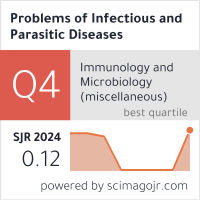PHYLOGENETIC ANALYSIS OF TWELVE BULGARIAN SEQUENCES BASED ON PARTIAL OPEN READING FRAME 2 GENOME FRAGMENT OF HEPATITIS E VIRUS
DOI:
https://doi.org/10.58395/y45wev44Keywords:
hepatitis E virus, genotyping, Sanger sequencingAbstract
Background: Hepatitis E virus (HEV) causes both acute and chronic liver inflammation. HEV is transmitted through the fecal-oral mechanism and infects both animals and humans. The virus belongs to the Hepeviridae family and its genome is a single stranded RNA molecule. Thanks to molecular sequencing methods different genotypes and subgenotypes have been established. The aim of the present study was to identify and characterize Bulgarian HEV sequences by applying Sanger sequencing technique for a genome fragment in Open Reading Frame 2 (ORF2 region).
Material and methods: Twelve retrospective samples from patients with serologically confirmed HEV infection (anti-HEV IgM and IgG positive) were sequenced by Sanger sequencing. Sequencing data were analysed by BioEdit, MEGA11 and NCBI Genbank software tools.
Results: The results revealed that all isolates assign to species Paslahepevirus balayani. Phylogenetic analysis showed that HEV isolates were characterized with considerable genetic diversity. The sequences were sub-clustered into the following subgenotypes: HEV-3e, 3m, 3f and 3c.
Conclusion: We successfully applied the Sanger method for hepatitis E virus RNA sequencing. The established heterogeneity of subgenotypes requires further study in order to determine the circulation of all possible subgenotypes of HEV in the country.
Downloads
References
World health organization. [Online] https://www.who.int/news-room/fact-sheets/detail/hepatitis-e
Purdy MA, Drexler JF, Meng XJ, et al. ICTV Virus TaxonomyProfile: Hepeviridae 2022. J Gen Virol. 2022;103(9):10.1099/jgv.0.001778. https://doi.org/10.1099/jgv.0.001778
Woo P, Lau S, Teng J, et al. New Hepatitis E Virus Genotype in Camels, the Middle East. Emerging Infectious Diseases.2014;20(6):1044-1048. https://doi.org/10.3201/eid2212.160979
Smith DB, Simmonds P, Izopet J, et al. Proposed reference sequences for hepatitis E virus subtypes. J Gen Virol.2016;97(3):537-542. https://doi.org/10.1099/jgv.0.000393
Kamar N, Bendall R, Legrand-Abravanel F, et al. Hepatitis E [published correction appears in Lancet. 2012 Aug 25;380(9843):730]. Lancet. 2012;379(9835):2477-2488. https://doi.org/10.1016/S0140-6736(11)61849-7
Lu L, Li C, Hagedorn CH. Phylogenetic analysis of global hepatitis E virus sequences: genetic diversity, subtypes and zoonosis. Rev Med Virol. 2006;16(1):5-36. https://doi.org/10.1002/rmv.482
Smith DB, Izopet J, Nicot F, Simmonds P, Jameel S, Meng XJ et al. Update: proposed reference sequences for subtypes of hepatitis E virus (species Orthohepevirus A). J. gen. virol. 2020 Jul;101(7):692-698. https://doi.org/10.1099/jgv.0.0014358
Subissi L, Peeters M, Lamoral S, Klamer S, Suin V, Van Gucht S. Subtype-specific differences in the risk of hospitalisation among patients infected with hepatitis E virus genotype 3 in Belgium, 2010-2018. Epidemiol Infect. 2019;147:e224. https://doi.org/10.1017/S0950268819001122
Huang FF, Haqshenas G, Guenette DK, et al. Detection by reverse transcription-PCR and genetic characterization of field isolates of swine hepatitis E virus from pigs in different geographic regions of the United States. J Clin Microbiol. 2002;40(4):1326-1332. https://doi.org/10.1128/JCM.40.4.1326-1332.2002
Takahashi M, Nishizawa T, Yoshikawa A, et al. Identification of two distinct genotypes of hepatitis E virus in a Japanese patient with acute hepatitis who had not travelled abroad. J Gen Virol. 2002;83(Pt 8):1931-1940. https://doi.org/10.1099/0022-1317-83-8-1931
Ahn JM, Kang SG, Lee DY, Shin SJ, Yoo HS. Identification of novel human hepatitis E virus (HEV) isolates and determination of the seroprevalence of HEV in Korea. J Clin Microbiol. 2005;43(7):3042-3048. https://doi.org/10.1128/JCM.43.7.3042-3048.2005
van der Poel WH, Verschoor F, van der Heide R, et al. Hepatitis E virus sequences in swine related to sequences in humans, The Netherlands. Emerg Infect Dis. 2001;7(6):970-976.https://doi.org/10.3201/eid0706.010608
Wu JC, Chen CM, Chiang TY, et al. Spread of hepatitis E virus among different-aged pigs: two-year survey in Taiwan. J Med Virol. 2002;66(4):488-492. https://doi.org/10.1002/jmv.2170
Battistini R, Serracca L, Razzuoli E, et al. Hepatitis E Virus (HEV): Identification of Subtypes 3b and 3m in Wild Boar Population in Liguria Region, Italy. Pathogens. 2022;11(11):1236. Published 2022 Oct 26. https://doi.org/10.3390/pathogens11111236
Pei Y, Yoo D. Genetic characterization and sequence heterogeneity of a canadian isolate of Swine hepatitis E virus. J Clin Microbiol. 2002;40(11):4021-4029. https://doi.org/10.1128/JCM.40.11.4021-4029.2002
Ward P, Müller P, Letellier A, et al. Molecular characterization of hepatitis E virus detected in swine farms in the province of Quebec. Can J Vet Res. 2008;72(1):27-31.
Bruni R, Villano U, Equestre M, et al. Hepatitis E virus genotypes and subgenotypes causing acute hepatitis, Bulgaria, 2013-2015. PLoS One. 2018;13(6):e0198045. Published 2018 Jun 7. https://doi.org/10.1371/journal.pone.0198045
Banks M, Bendall R, Grierson S, Heath G, Mitchell J, Dalton H. Human and porcine hepatitis E virus strains, United Kingdom. Emerg Infect Dis. 2004;10(5):953-955. https://doi.org/10.3201/eid1005.030908
Zanetti AR, Schlauder GG, Romanò L, et al. Identification of a novel variant of hepatitis E virus in Italy. J Med Virol. 1999;57(4):356-360. https://doi.org/10.1002/(sici)1096-9071(199904)57:4<356::aid-jmv5>3.0.co;2-d
Festa S, Garbuglia AR, Baccini F, et al. Acute fulminant hepatitis E virus genotype 3e infection: description of the first case in Europe. Scand J Infect Dis. 2014;46(10):727-731. https://doi.org/10.3109/00365548.2014.928417
Schlauder GG, Desai SM, Zanetti AR, Tassopoulos NC, Mushahwar IK. Novel hepatitis E virus (HEV) isolates from Europe: evidence for additional genotypes of HEV. J Med Virol. 1999;57(3):243-251. https://doi.org/10.1002/(sici)1096-9071(199903)57:3<243::aid-jmv6>3.0.co;2-r
Renou C, Pariente A, Cadranel JF, Nicand E, Pavio N. Clinically silent forms may partly explain the rarity of acute cases of autochthonous genotype 3c hepatitis E infection in France. J Clin Virol. 2011;51(2):139-141. https://doi.org/10.1016/j.jcv.2011.02.013
Martelli F, Toma S, Di Bartolo I, et al. Detection of Hepatitis E Virus (HEV) in Italian pigs displaying different pathological lesions. Res Vet Sci. 2010;88(3):492-496. https://doi.org/10.1016/j.rvsc.2009.12.011
Dell'Amico MC, Cavallo A, Gonzales JL, et al. Hepatitis E virus genotype 3 in humans and Swine, Bolivia. Emerg Infect Dis. 2011;17(8):1488-1490. https://doi.org/10.3201/eid1708.100769
Worm HC, Schlauder GG, Wurzer H, Mushahwar IK. Identification of a novel variant of hepatitis E virus in Austria: sequence, phylogenetic and serological analysis. J Gen Virol. 2000;81(Pt 12):2885-2890. https://doi.org/10.1099/0022-1317-81-12-2885
Wang B, Meng XJ. Structural and molecular biology of hepatitis E virus. Comput Struct Biotechnol J. 2021;19:1907-1916. Published 2021 Apr 7. https://doi.org/10.1016/j.csbj.2021.03.038
Nagashima S, Takahashi M, Kobayashi T, et al. Characterization of the Quasi-Enveloped Hepatitis E Virus Particles Released by the Cellular Exosomal Pathway. J Virol. 2017;91(22):e00822-17. Published 2017 Oct 27. https://doi.org/10.1128/JVI.00822-17
Bradley DW. Enterically-transmitted non-A, non-B hepatitis. Br Med Bull. 1990;46(2):442-461.. https://doi.org/10.1093/oxfordjournals.bmb.a072409
Mori Y, Matsuura Y. Structure of hepatitis E viral particle. Virus Res. 2011;161(1):59-64. https://doi.org/10.1016/j.virusres.2011.03.015
Graff J, Torian U, Nguyen H, Emerson SU. A bicistronic subgenomic mRNA encodes both the ORF2 and ORF3 proteins of hepatitis E virus. J Virol. 2006;80(12):5919-5926. https://doi.org/10.1128/JVI.00046-06
Emerson SU, Purcell RH. Hepatitis E virus. Rev Med Virol. 2003;13(3):145-154.https://doi.org/10.1002/rmv.384
Tsarev SA, Emerson SU, Reyes GR, et al. Characterization of a prototype strain of hepatitis E virus. Proc Natl Acad Sci U S A. 1992;89(2):559-563. https://doi.org/10.1073/pnas.89.2.559
Ropp SL, Tam AW, Beames B, Purdy M, Frey TK. Expression of the hepatitis E virus ORF1. Arch Virol. 2000;145(7):1321-1337. https://doi.org/10.1007/s007050070093
Graff J, Nguyen H, Yu C, et al. The open reading frame 3 gene of hepatitis E virus contains a cis-reactive element and encodes a protein required for infection of macaques. J Virol. 2005;79(11):6680-6689. https://doi.org/10.1128/JVI.79.11.6680-6689.200535
Boxman ILA, Jansen CCC, Hägele G, et al. Porcine blood used as ingredient in meat productions may serve as a vehicle for hepatitis E virus transmission. Int J Food Microbiol. 2017;257:225-231. https://doi.org/10.1016/j.ijfoodmicro.2017.06.029
Benson DA, Cavanaugh M, Clark K, et al. GenBank. Nucleic Acids Res. 2013;41(Database issue):D36-D42. https://doi.org/10.1093/nar/gks1195
Palombieri A, Tsachev I, Sarchese V, et al. A Molecular Study on Hepatitis E Virus (HEV) in Pigs in Bulgaria. Vet Sci. 2021;8(11):267. Published 2021 Nov 6.https://doi.org/10.3390/vetsci8110267
Golkocheva-Markova E, Ismailova C, Kevorkyan A, et al. Age and Gender Trends in the Prevalence of Markers for Hepatitis E Virus Exposure in the Heterogeneous Bulgarian Population. Life (Basel). 2023;13(6):1345. Published 2023 Jun 8. https://doi.org/10.3390/life13061345
Abravanel F, Dimeglio C, Castanier M, et al. Does HEV-3 subtype play a role in the severity of acute hepatitis E?. Liver Int. 2020;40(2):333-337. https://doi.org/10.1111/liv.14329
Ulbert ÁB, Bukva M, Magyari A, et al. Characteristics of hepatitis E viral infections in Hungary. J Clin Virol. 2022;155:105250. https://doi.org/10.1016/j.jcv.2022.105250
Gorski I, Babić I, Bingulac-Popović J, et al. Prevalence of HEV RNA in Croatian blood donors. Transfus Clin Biol. 2023;30(2):244-248. https://doi.org/10.1016/j.tracli.2023.01.005
Schemmerer M, Wenzel JJ, Stark K, Faber M. Molecular epidemiology and genotype-specific disease severity of hepatitis E virus infections in Germany, 2010-2019. Emerg Microbes Infect. 2022;11(1):1754-1763. https://doi.org/10.1080/22221751.2022.2091479
Zahmanova G, Takova K, Tonova V, et al. The Re-Emergence of Hepatitis E Virus in Europe and Vaccine Development. Viruses. 2023;15(7):1558. Published 2023 Jul 16.https://doi.org/10.3390/v15071558
Zehender G, Ebranati E, Lai A, et al. Phylogeography and phylodynamics of European genotype 3 hepatitis E virus. Infect Genet Evol. 2014;25:138-143. https://doi.org/10.1016/j.meegid.2014.04.016
De Sabato L, Ianiro G, Alborali GL, Kroneman A, Grierson SS, Krumova-Valcheva GL et al. Molecular Characterization and Phylogenetic Analysis of Hepatitis E Virus (HEV) Strains from Pigs Farmed in Eight European Countries between 2020 and 2022. Transbound. Emerg. Dis.. 2023 Dec 7;2023:2806835. https://doi.org/10.1155/2023/2806835
Nicot F, Dimeglio C, Migueres M, et al. Classification of the Zoonotic Hepatitis E Virus Genotype 3 Into Distinct Subgenotypes. Front Microbiol. 2021;11:634430. Published 2021 Jan 28. https://doi.org/10.3389/fmicb.2020.634430
Nei M. and Kumar S. . Molecular Evolution and Phylogenetics. Oxford University Press, New York. 2000; https://doi.org/10.1017/S0016672301219405
Tamura K, Stecher G, Kumar S. MEGA11: Molecular Evolutionary Genetics Analysis Version 11. Mol Biol Evol. 2021;38(7):3022-3027. https://doi.org/10.1093/molbev/msab120
Felsenstein J. CONFIDENCE LIMITS ON PHYLOGENIES: AN APPROACH USING THE BOOTSTRAP. Evolution. 1985;39(4):783-791. https://doi.org/10.1111/j.1558-5646.1985.tb00420.x
Tamura K, Nei M. Estimation of the number of nucleotide substitutions in the control region of mitochondrial DNA in humans and chimpanzees. Mol Biol Evol. 1993;10(3):512-526. https://doi.org/10.1093/oxfordjournals.molbev.a040023
Downloads
Published
Issue
Section
License
Copyright (c) 2024 Chiydem Ismailova, Asq Stoyanova, Viliana Yoncheva, Dr. Tencho Tenev, Lubomira Nikolaeva-Glomb, MD, PhD , Elitsa Golkocheva-Markova, PhD (Author)

This work is licensed under a Creative Commons Attribution 4.0 International License.






